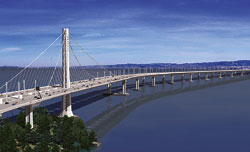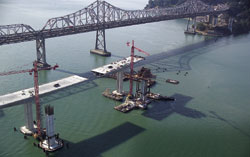 |
 |
| Missing Link. The eastbound tub will go in next month, just weeks before Caltrans opens bids on the signature span. (Images courtesy of Caltrans/Photo Bill Hall) |
Replacing the San Francisco-Oakland Bay Bridges eastern spans without further setbacks hinges on crucial milestones in the months ahead. Among them is a 2,000-ton mega-lift planned for mid-January that will open the way for the bridges controversial signature span.
Bids are due Feb. 1 for construction of the self-anchored suspension span, intended to link Yerba Buena Island and a 1.3-mile-long, segmental concrete "skyway" that stretches to Oakland. The spans cables, strung from a 510-ft-tall tower, will anchor to the bridge deck.
Another round of difficult tasks begins next month, when ironworkers will receive an orthotropic steel girder weighing about 2,000 tons and rotate it 90° on top of its delivery barge. Then, in a high-strung procedure that will grind on for half a day or more, riggers will hoist the hulking girder 200 ft above the water, keeping the load within 1Ú8-in. of its final attitude.
The green light for lifting the eastbound girder came on a rush order in September. The short lead time "really put the crunch on things," says Pete Ashton, vice president of Bigge Crane and Rigging Co., San Leandro, Calif.
The 200-ft-long, 85-ft-wide and 20-ft-tall "tub" serves as a transition between the skyway and the not-yet-built suspension span. Fabricated for $16 million by USI Inc., Vancouver, Wash., the eastbound and westbound tubs will be jacked up and placed on self-propelled modular transporters that are manufactured in Germany. Pinned together, the platforms resemble a giant skateboard that rides on hundreds of hydraulically powered rubber tires. Equipped with hydraulic suspension at each wheel, the platforms will roll each span onto a 250-ft-long barge.
Bigge plans to receive the first barge near the western edge of the 1.3-mile skyway in early January. There, ironworkers will rig up Dutch-made strand jacks capable of pulling a combined 2,870 tons. Computer controls tie the jacks together, for synchronized movement within 1Ú32 in.
Once lifted, steel falsework put up by general contractor KFM, a joint venture led by Kiewit Pacific Co., will support the tubs while the suspension span goes up over the next several years.
Though not a record-breaking lift, the sensitive operation still "needs a lot of care," says Guido Schwager, president of Schwager Davis Inc., San Jose. His company designed lifting equipment that KFM is using to hoist and tension the skyway segments (ENR 5/2 p. 21).
Just before the big lift, foundations under the nearby falsework will leave no room for the barge to float under the skyway from end-to-end. The ship will arrive perpendicular to the roadway and, in a tight swivel maneuver, Bigge will use the transporters to rotate the tub.
Four 365-ton strand jacks will rest atop four 60-ft-long girders, each cantilevered 28 ft off the skyway and tied down with threaded rods. KFM will counterweight the bridge. On the other side of the tub, Bigge will center six 235-ton jacks on twin 125-ft-long girders. They will sit on erection towers.
Bigge is scheduled to repeat the lift in June for the westbound tub. Such rigging work demands much investment in complex, often foreign-made equipment that yields small, incremental returns. Jacks similar to the ones in next months lift range from $100,000 to $500,000 per unit. "The paint job costs more than the lifting," Ashton says.
The self-anchored span is coming, too, once the California Dept. of Transportation accepts a bid. Plans for the innovative but expensive span went back
up this summer with minor changes. Alarm over the skyway, now 80% done, cropped up this spring over alleged poor welding. Investigations later found nothing wrong.

Post a comment to this article
Report Abusive Comment